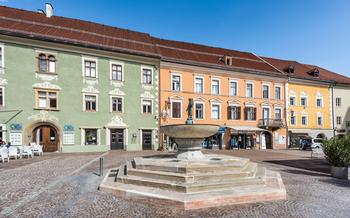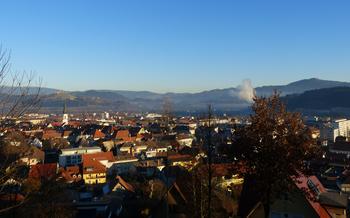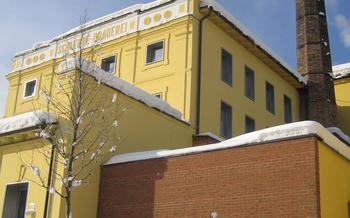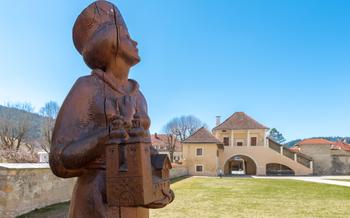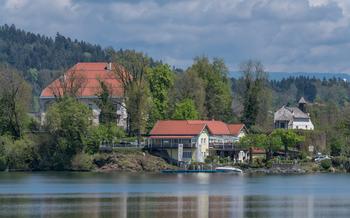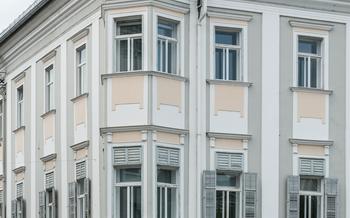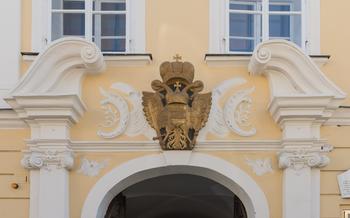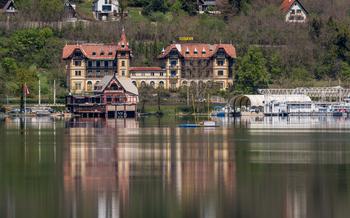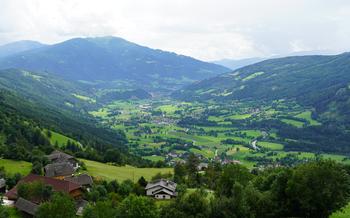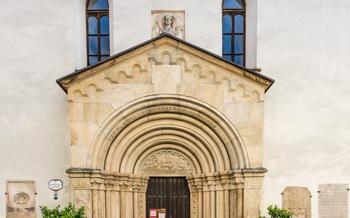
The Diocesan Museum
- A Journey Through Time: The Diocesan Museum's History
- A Treasure Trove of Art: The Diocesan Museum's Collections
- From the Middle Ages to Modern Times: Exploring the Museum's Timeline
- A Masterful Display: Highlights of the Diocesan Museum's Collection
- A Journey of Discovery: Guided Tours and Educational Programs
- Step into the Past: The Museum's Historic Setting
- A Feast for the Senses: Dining and Shopping Options Nearby
- Beyond the Museum: Exploring Klagenfurt am Wörthersee
- Getting There: Transportation and Accessibility
- Public Transportation
- Parking Options
- Accessibility
- Plan Your Visit: Practical Tips for a Memorable Experience
- Capture the Moment: Photography and Social Media
- Step into History: Interactive Exhibitions and Virtual Tours
- Engage with History: Workshops and Lectures
- A Place for Reflection: The Museum as a Sanctuary
- Insider Tip: Unveiling Hidden Gems
A Journey Through Time: The Diocesan Museum's History
The Diocesan Museum in Klagenfurt am Wörthersee, Austria, is a journey through time, showcasing the rich artistic and cultural heritage of the Gurk Diocese. Its roots can be traced back to the 19th century when the Gurk Diocesan Museum was established to preserve and display the diocese's collection of sacred art. In the early 20th century, the museum was relocated from Gurk to Klagenfurt, a move that significantly expanded its visibility and accessibility. Today, the museum stands as a testament to the diocese's commitment to preserving its cultural treasures and sharing them with the world. It plays a vital role in promoting understanding and appreciation of the region's artistic heritage, fostering a deeper connection between visitors and the history of the Gurk Diocese.
A Treasure Trove of Art: The Diocesan Museum's Collections
The Diocesan Museum in Klagenfurt am Wörthersee, Austria, houses a treasure trove of art, showcasing the rich cultural and artistic heritage of the Gurk diocese. The museum's extensive collection includes masterpieces of painting, sculpture, ecclesiastical treasures, and historic tapestries.
Masterpieces of Painting
The museum's collection of paintings spans from the Middle Ages to the modern era, featuring works by renowned artists from various periods. Visitors can admire exquisite medieval paintings characterized by vibrant colors and intricate details, as well as paintings from the Renaissance and Baroque periods that showcase the influence of these artistic movements. The museum also boasts a notable collection of 19th-century Romantic paintings that capture the essence of the era.
Sculptures that Speak
The Diocesan Museum's collection of sculptures is equally impressive, featuring exquisite works from the Late Gothic and Baroque periods. Visitors can marvel at the intricate carvings and lifelike details of these sculptures, which depict religious figures, saints, and mythical creatures. The museum also houses a collection of contemporary sculptures that offer a fresh perspective on the art form.
Ecclesiastical Treasures
The museum's collection of ecclesiastical treasures includes precious artifacts, vestments, and liturgical objects that have been used in religious ceremonies throughout the centuries. Visitors can admire ornate chalices, intricate monstrances, and beautifully embroidered vestments that reflect the artistry and craftsmanship of the region.
A Tapestry of History
The Diocesan Museum's collection of historic tapestries and textiles is a testament to the region's rich weaving tradition. Visitors can explore a series of tapestries that depict biblical scenes, mythological stories, and historical events, providing a glimpse into the artistic and cultural influences that shaped the region.
From the Middle Ages to Modern Times: Exploring the Museum's Timeline
The Diocesan Museum's collection spans centuries, offering a comprehensive journey through the evolution of art and artistic styles. The museum's medieval section showcases exquisite illuminated manuscripts, intricate goldsmithing, and captivating sculptures that reflect the religious and cultural influences of the period. The Renaissance and Baroque eras are represented by stunning paintings, sculptures, and decorative arts, showcasing the opulence and grandeur of these artistic movements.
Moving into the 19th century, the museum's collection delves into the Romantic era, characterized by its emotional intensity, dramatic landscapes, and focus on individualism. The museum's collection from this period includes paintings, sculptures, and drawings that capture the spirit of Romanticism. The museum also houses a significant collection of modern and contemporary artworks, reflecting the diverse artistic expressions of the 20th and 21st centuries. These works explore a wide range of themes, techniques, and materials, offering a glimpse into the artistic landscape of our time.
A Masterful Display: Highlights of the Diocesan Museum's Collection
The Diocesan Museum in Klagenfurt am Wörthersee boasts a remarkable collection of artworks, each with its own unique story and significance. Among the highlights of the collection are the following masterpieces:
-
The Gurk Cross: This exquisite 12th-century processional cross is a masterpiece of Romanesque goldsmithing. It features intricate filigree work, precious stones, and enamel, and is considered one of the most important works of art in the museum's collection.
-
The Immaculata Statue: This stunning Baroque sculpture portrays the Virgin Mary as the Immaculate Conception. Created in the 18th century, the statue is a symbol of purity and grace, and is revered by many visitors to the museum.
-
The Klagenfurt Altar: This magnificent Gothic altarpiece is a masterpiece of wood carving. Created in the 15th century, the altar features intricate carvings depicting scenes from the life of Christ and the Virgin Mary. Its vibrant colors and expressive figures make it a must-see for any visitor to the museum.
-
The Diocesan Museum's Tapestries: The museum houses a collection of historic tapestries that offer a glimpse into the artistic and cultural heritage of the region. Among the most notable tapestries is the "Story of Abraham" series, which depicts scenes from the life of the biblical patriarch Abraham. These tapestries are remarkable for their intricate weaving, rich colors, and historical significance.
A Journey of Discovery: Guided Tours and Educational Programs
The Diocesan Museum offers a range of guided tours that bring the museum's collection to life. Knowledgeable guides lead visitors through the galleries, sharing insights into the artworks, their historical context, and the stories behind their creation. These tours provide an immersive experience, allowing visitors to connect with the art on a deeper level.
In addition to guided tours, the museum also offers a variety of educational programs designed for visitors of all ages. Workshops, lectures, and interactive activities engage visitors with the museum's collection in a fun and hands-on way. These programs are a great opportunity to learn more about art history, explore different techniques, and create your own works of art inspired by the museum's masterpieces.
The museum also offers tailored programs and activities for school groups, making history and art come alive for young learners. These programs are designed to meet the specific needs of each group, and can include guided tours, workshops, and hands-on activities. Through these programs, students can explore the museum's collection, learn about different art forms, and develop their critical thinking and creativity skills.
Step into the Past: The Museum's Historic Setting
The Diocesan Museum is not just home to a treasure trove of art and history; it is also housed in a building that is steeped in its own rich history. The Palais Gurk, which now houses the museum, was once the residence of the bishops of Gurk. This magnificent building, with its elegant facade and intricate architectural details, offers a glimpse into the opulent lifestyle of the former ecclesiastical leaders.
Beyond the museum's walls, visitors can explore the Diocesan Museum's Gardens, a serene and beautifully landscaped oasis in the heart of the city. Here, visitors can stroll along winding paths, admire the colorful blooms, and find a tranquil spot to relax and reflect.
Just a short walk from the museum, visitors can step into Klagenfurt Cathedral, a stunning example of Gothic architecture. This awe-inspiring edifice, with its soaring spires and intricate stained-glass windows, is a must-see for anyone interested in the history and culture of Klagenfurt.
A Feast for the Senses: Dining and Shopping Options Nearby
After immersing yourself in the world of art and history, it's time to indulge in some culinary delights. Klagenfurt am Wörthersee offers a tempting array of dining options, from traditional Austrian cuisine to international fare. Savor the flavors of classic dishes like Wiener Schnitzel, Käsespätzle, or Tafelspitz at one of the many restaurants in the city center. For a unique dining experience, head to one of the traditional Carinthian restaurants, where you can try local specialties such as Kasnudeln (filled pasta) or Schmarren (a shredded pancake).
Combine your culinary adventure with a shopping spree at the local boutiques and shops. Discover unique souvenirs, handcrafted goods, and local delicacies to take home as mementos of your visit. From traditional Austrian clothing and accessories to regional specialties like chocolates, jams, and honey, there's something for everyone to find. Don't miss the opportunity to taste the region's famous Carinthian wine, known for its fresh and fruity flavors.
Beyond the Museum: Exploring Klagenfurt am Wörthersee
The Diocesan Museum is not only a treasure trove of art and history, but it also serves as a gateway to exploring the captivating city of Klagenfurt am Wörthersee. Step outside the museum and immerse yourself in the vibrant atmosphere of this charming city.
Stroll along the picturesque streets of Klagenfurt's historic city center, where you'll be greeted by colorful buildings, charming squares, and architectural landmarks. Admire the stunning facades of the Rathaus (City Hall), the Landhaus (Provincial Parliament), and the Neuer Platz (New Square), which transport you back in time.
Venture beyond the city center and discover the stunning beauty of Lake Wörthersee, a popular destination for swimming, boating, and lakeside relaxation. Take a leisurely stroll along the lake's promenade, soaking up the breathtaking views of the turquoise waters and the surrounding mountains. Indulge in water sports such as sailing, windsurfing, or kayaking to experience the lake's natural beauty from a different perspective.
Klagenfurt is also home to a variety of other museums, galleries, and cultural attractions. Visit the Museum of Modern Art to admire works by renowned Austrian and international artists. Explore the Carinthian Museum to learn about the region's rich history and culture. Attend a concert at the Klagenfurt Concert Hall or a performance at the Klagenfurt Stadttheater to immerse yourself in the city's vibrant arts scene.
Getting There: Transportation and Accessibility
Public Transportation
Reaching the Diocesan Museum is a breeze with Klagenfurt's well-connected public transportation system. Buses and trams stop right outside the museum, making it easily accessible from anywhere in the city. Simply hop on the appropriate line and enjoy the ride, taking in the sights of Klagenfurt as you approach your destination.
Parking Options
For those arriving by car, there are several convenient parking options near the museum. The closest parking garage, Citypark Klagenfurt, is just a short walk away, providing secure and sheltered parking for your vehicle. Additional parking spaces can be found along the streets surrounding the museum, offering a more budget-friendly alternative.
Accessibility
The Diocesan Museum is committed to ensuring that all visitors have a welcoming and accessible experience. The museum is fully wheelchair accessible, with ramps and elevators providing easy access to all floors and exhibits. Large-print guides and audio guides are available for those with visual or hearing impairments, and staff members are always on hand to assist with any additional needs.
Plan Your Visit: Practical Tips for a Memorable Experience
Opening Hours: The Diocesan Museum is open from Tuesday to Sunday, with varying hours depending on the season. Check the museum's website or official visitor guide for the most up-to-date information on opening hours. Plan your visit accordingly to avoid disappointment.
Admission Fees: Admission to the Diocesan Museum is subject to a fee. However, reduced rates are available for students, seniors, and groups. The museum also offers free admission on the first Sunday of every month. Be sure to inquire about any special discounts or concessions that may apply to you.
Guided Tours: Guided tours of the Diocesan Museum are available in various languages, including English, German, and Italian. These tours provide a more in-depth look at the museum's collection and history. It is recommended to book a guided tour in advance, especially during peak season, to secure your spot.
Photography: Photography is generally permitted in the Diocesan Museum, but there may be restrictions on the use of flash photography or tripods. It is always advisable to check with the museum staff before taking photographs to ensure that you are not violating any rules or disturbing other visitors.
Capture the Moment: Photography and Social Media
The beauty and historical significance of the Diocesan Museum's collection provide a wealth of opportunities for capturing stunning photographs. Visitors are encouraged to bring their cameras to document their journey through time. Share your experience with the world by using relevant hashtags and tagging the museum on social media platforms like Instagram. The museum regularly hosts captivating photography exhibitions that showcase the talents of local and international artists, offering a unique perspective on the museum's collection.
Step into History: Interactive Exhibitions and Virtual Tours
The Diocesan Museum in Klagenfurt am Wörthersee embraces technology to enhance the visitor experience, offering a range of interactive exhibitions and virtual tours that bring history to life.
Interactive displays throughout the museum allow visitors to engage with the collection in a hands-on manner. Touchscreens, multimedia presentations, and augmented reality technology provide additional information, insights, and interactive experiences, making the museum's collection more accessible and engaging for visitors of all ages.
For those unable to visit the museum in person, virtual tours offer an immersive way to explore the collection from anywhere in the world. High-resolution images, 360-degree panoramas, and detailed descriptions allow visitors to navigate through the museum's galleries, zoom in on artworks, and learn about their history and significance.
With its commitment to innovation and technology, the Diocesan Museum in Klagenfurt am Wörthersee provides visitors with a dynamic and engaging experience that deepens their understanding of the region's rich artistic and cultural heritage.
Engage with History: Workshops and Lectures
The Diocesan Museum offers a variety of workshops and lectures that provide visitors with an opportunity to delve deeper into the museum's collection and themes. These educational programs are led by experts in the fields of art history, theology, and cultural studies, who share their knowledge and insights with participants.
Workshops at the museum are designed to be interactive and engaging, allowing visitors to get hands-on with the museum's collection. Participants can learn about different art techniques, create their own artworks inspired by the museum's pieces, or explore specific themes in greater depth.
Lectures at the museum cover a wide range of topics related to the museum's collection and the history and culture of the region. Visitors can attend lectures on the history of the diocese, the development of art and architecture in Carinthia, or the lives and works of specific artists.
By participating in workshops and lectures at the Diocesan Museum, visitors can gain a deeper understanding of the museum's collection and the rich history and culture of the region. These educational programs are a great way to engage with the museum's exhibits and to learn more about the art and history of Carinthia.
A Place for Reflection: The Museum as a Sanctuary
Amidst the vibrant displays and historical artifacts, the Diocesan Museum offers visitors a sanctuary for reflection and spiritual contemplation. The museum's tranquil atmosphere and serene surroundings create an inviting space for individuals to connect with their inner selves and explore the deeper meanings behind the artworks.
As visitors wander through the galleries, they can find moments of peace and tranquility, allowing the beauty and symbolism of the art to wash over them. The museum's collection invites viewers to contemplate themes of faith, spirituality, and the human experience, encouraging them to delve into their own beliefs and values.
For those seeking a deeper connection, the museum offers opportunities for meditation and mindfulness practices. The serene environment and the museum's rich collection provide an ideal backdrop for individuals to cultivate inner peace and self-awareness.
Whether visitors are seeking solace, inspiration, or a deeper understanding of their own spirituality, the Diocesan Museum offers a sanctuary where they can find meaning and connection amidst the treasures of the past.
Insider Tip: Unveiling Hidden Gems
Beyond the main galleries, the Diocesan Museum holds many secrets waiting to be discovered by curious visitors. Explore hidden corners and uncover lesser-known treasures that may not be immediately apparent. Temporary exhibitions often showcase unique and rarely seen artworks, providing a fresh perspective on the museum's collection. Don't hesitate to ask museum staff for their personal recommendations; they may reveal hidden gems that only insiders know about. Embrace the opportunity to delve deeper into the museum's treasures and create a truly memorable experience.
